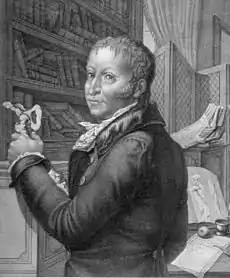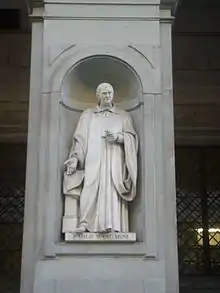Paolo Mascagni
Paolo Mascagni (January 25, 1755[lower-alpha 1] – October 19, 1815) was an Italian physician and anatomist. He is most well known for publishing the first complete description of the lymphatic system.[2]
Paolo Mascagni | |
|---|---|
 Paolo Mascagni | |
| Born | January 25, 1755 Pomarance, Italy |
| Died | October 19, 1815 (aged 60) Chiusdino, Italy |
| Occupation | Anatomist |
| Parent(s) | Aurelio Mascagni & Elizabeth Burroni |

Biography
Early life
Mascagni was born in the comune of Pomarance (in the Province of Pisa) to Aurelio Mascagni and Elisabetta Burroni, both belonging to old gentry families of Chiusdino (in the Province of Siena). He studied philosophy and medicine at the University of Siena. Upon graduating in 1777, renowned anatomist Pietro Tabarrini took Mascagni as an assistant. Upon Tabarrini's death in 1780, Mascagni was appointed as an anatomy lecturer at the University of Siena.[3]
Career

As a young man, Mascagni was interested in geological sciences, as evidenced by his several papers on the Lagoni (thermal springs) of Siena and Volterra. Upon graduation, he turned his interest to the human lymphatic system. His many discoveries in this field led to the composition and publication of Vasorum lymphaticorum corporis humani historia et iconographia in 1787.[2] He was elected a corresponding member of the Royal Swedish Academy of Sciences in 1796, and president of the Accademia dei Fisiocritici in 1798.
During the French occupation of Tuscany in the spring of 1799, Mascagni showed himself to be an enthusiastic Jacobin. For this reason, he spent seven months in prison after the French were expelled. Mascagni was freed from prison by a motu proprio of the King of Etruria, who on October 22, 1801 appointed Mascagni a professor of anatomy at the University of Pisa, with the additional charge of lecturing twice a week at the Hospital of Santa Maria Nuova in Florence.
In 1807, Mascagni was appointed professor of anatomy at the University of Florence. There, he wrote Treatise of Anatomy.[3]
Collaborations
In 1781, Mascagni began advising sculptor Clemente Susini, who was working on a collection of human anatomical waxes. The collection was completed in 1786 and consisted of approximately 800 pieces.[4]
In 1801, the Sardinian anatomist Francesco Antonio Boi became a student of Mascagni. Mascagni and Boi entered into a close collaboration as well as a personal friendship. The anatomical waxes are held in the Museo archeologico nazionale in Cagliari.[5]
Legacy
Mascagni posthumously published two works:
- Prodromo della grande anatomia (1821)
- Anatomicae universae iconae (1823)
Mascagni has been posthumously credited with the first discovery of meningeal lymphatic vessels, though his findings were disregarded during his lifetime.[13] These vessels were conclusively discovered in mice in 2014 and subsequently confirmed in humans and non-human primates in 2017.[14]
Notes
- This is the most probable date, but some place his birth date on January 28 or February 5.[1]
References
- Arieti, Stefano (2008). "MASCAGNI, Paolo". Dizionario Biografico degli Italiani (in Italian). 71.
- Eimas, Richard (June 12, 1983). "The Great Anaotomy of Paolo Mascagni". Books at Iowa. 38 (38): 46–53. doi:10.17077/0006-7474.1451. Retrieved April 20, 2019.
- Di Matteo B, Tarabella V, Filardo G, Viganò A, Tomba P, Kon E, Marcacci M (2015). "Art in science: Giovanni Paolo Mascagni and the art of anatomy". Clin Orthop Relat Res. 473 (3): 783–8. doi:10.1007/s11999-014-3909-y. PMC 4317432. PMID 25245529.
- "Clemente Michelangelo Susini" (in Italian). Università di Bologna. Archived from the original on February 18, 2013. Retrieved January 10, 2013.
- Taccari, Egisto (1969). "BOI, Francesco Antonio". Dizionario Biografico degli Italiani. 11. Treccani. Retrieved January 12, 2013.CS1 maint: ref=harv (link)
- "Paolo Mascagni", Fisiocritici Academy, 2006 Archived June 21, 2008, at the Wayback Machine
- Choulant, Ludwig, Mortimer, Frank, Fielding, Hudson G., Streeter, Edward C., "History and bibliography of anatomic illustration in its relation to anatomic science and the graphic arts", 1852
- Knight, Charles, "Penny cyclopaedia of the Society for the diffusion of useful knowledge: Second supplement", 1858
- Antommarchi, Francesco C., "Anatomical Prints of the Human Body with Natural Dimensions", 1826
- Antommarchi, Francesco, "Prodromo della grande anatomia seconda opera postuma di Paolo Mascagni, posta in ordine, e poblicata a spese di una Societa innominata da Francesco Antommarchi", 1819
- Antommarchi, Francesco, "Tavole figurate di alcune parti organiche del corpo umano degli animali e dei vegetabili, esposte nel prodromo della grande anatomia di Paolo Mascagni", 1819
- Moodie, Roy L., "Anatomical Names with Biographical Sketches", 1917
- Moreno-Zambrano, D; Santana, D; Avila, D; Santibáñez, Rocío (April 9, 2018). "Lymphatics of the Central Nervous System: Forgotten first descriptions. (S39.003)". Neurology. 90 (15). doi:10.1016/0033-5894(85)90074-2.
- Da Mesquita S, Fu Z, Kipnis J (2018). "The Meningeal Lymphatic System: A New Player in Neurophysiology" (PDF). Neuron. 100 (2): 375–388. doi:10.1016/j.neuron.2018.09.022. PMC 6268162. PMID 30359603.